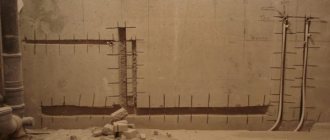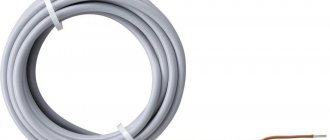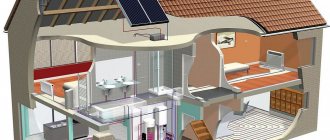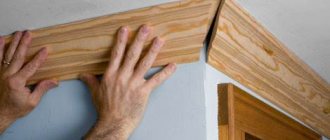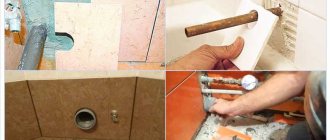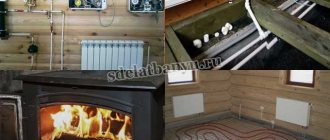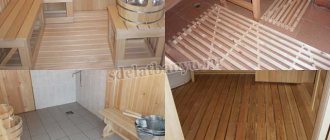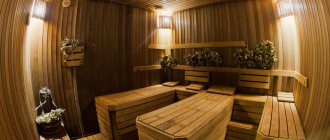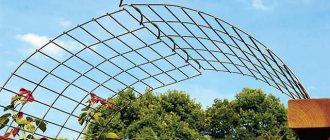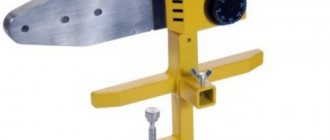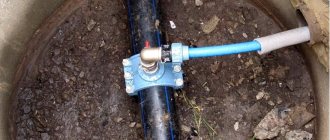Explaining to an experienced bathhouse attendant or an experienced steam lover why a stone mesh is needed on a bathhouse pipe is absolutely unnecessary. Anyone who has taken a steam bath at least once in their life knows how cruel and unforgiving a metal stove can be, especially a fire tube. This is a small section of metal chimney, only a meter long, connecting the flange of the furnace combustion chamber to the rest of the chimney duct.
A fire tube without a mesh with a stone heats the bathhouse too harshly
Basic rules and regulations
Before insulating a pipe in a bathhouse from the ceiling, you should study the following SNiP requirements:
- To ensure optimal draft force, a chimney pipe with a height of at least 5 m should be erected;
- A minimum distance of 250 mm must be maintained between the chimney pipe and the nearest combustible elements;
- If materials with insufficient fire protection are used for roofing, a spark arrester must be installed;
- A certain distance must be maintained between the upper stove ceiling and the ceiling: for metal pipes - more than 1.5 m, for brick chimneys - 0.5 m.
Elements of the chimney system
The main part of the chimney system is the stove pipe. There are 3 types with different sizes - 250, 500, 1000 mm in diameter.
The next element of the system is the throttle valve. It is used to adjust traction. It is a pipe with a built-in butterfly valve and an outward handle.
For installation you will also need tees, a cover, thermal insulation, a condensate collector, connections, an ash pan, special adapters, and various protective elements. Some of them are mandatory, while others serve as an addition to the combustion product removal system.
External chimney type: advantages
If your steam room is not in the Far North, then the option of arranging a bathhouse with an external chimney has undoubted advantages over a bulky, expensive, difficult-to-install internal smoke exhaust channel.
The external type of chimney is so called because the pipe goes outside the room. The outlet is carried out from the stove horizontally through the wall. The vertical part is located on the street.
Advantages of the external type of chimney:
- High fire safety. The short length of the chimney in the room, one technological hole in the wall for exhaust, reduces the risk of fire by several times, in comparison with the installation of an internal chimney.
- Ease of installation. All components are assembled in stages and are sold ready-made. Installing an external pipe with your own hands does not require special skills in handling metal and does not require special tools.
- Small sizes. Since the main part of the pipe runs along the street, the room remains completely at the disposal of the steamer.
- Easy to select the desired pipe diameter and length. Pre-fabricated pipes are designed for use with specific stoves. A heating equipment consultant will help you choose the optimal diameter of the chimney pipe for your stove.
- Simplicity of installation of heat and waterproofing of wall openings. You can purchase a ready-made kit for arranging a technological hole in accordance with all rules and safety requirements. The kit includes a horizontal pipe section, two fittings (external, internal), a package with thermal insulation of the required type in the required quantity. The cost of a simple adapter of small diameter starts from 1000 rubles. The price of a branded stainless steel set reaches 3,500 rubles.
We recommend that you read: How to build a plasterboard box yourself to disguise pipes in a toilet?
Ready-made chimney kits are sold both completely and in separate segments. It is convenient to use ready-made sandwich pipes (with thermal insulation).
It is recommended to purchase mineral wool with a characteristic of at least 800 degrees. Mineral wool with a heat resistance of 200-300 degrees in a humid environment quickly becomes unusable, losing its thermal insulation properties.
Which type of basket for stones is better?
One of the most effective heater models is shown in the diagram. The height of the mesh body is 66 cm, the diameter is selected depending on the cross-section of the chimney.
The above design with a conical perforated bottom, according to the manufacturers, effectively warms the air, even without spraying the stones with boiling water. Hot air rising from the oven penetrates through the bottom holes into the mesh container and warms up to a temperature of more than 100°C.
Experts recommend purchasing meshes with a minimum number of welding seams.
Assembly Tips
After constructing the chimney, as well as some time of use, it is important to take care of regular cleaning of the system. The most proven way to clean a chimney is to use mechanical tools.
Special brushes, weights, and in some cases a crowbar and a sledgehammer are suitable for this.
Working as a chimney sweep is a dirty job, so everything is taken out of the bathhouse in advance, the surfaces are covered with newspapers or film:
The simplest method is to use a special brush that can be used to clean the chimney. Simply insert the brush into the pipe, then gently push it upward until the resistance due to accumulated soot disappears. It should not be rotated around its axis, otherwise there is a risk that it will get stuck in the pipe and will have to be removed in parts. Another effective method of cleaning a chimney is burning aspen wood. The method will help with a small amount of soot on the surface of the pipe. When burning aspen logs, a better traction force is created, which is capable of removing soot from the chimney.
- Potato skins have similar properties. But to prepare the required amount of material, you will have to get serious about cleaning more than one kilogram of vegetables.
- Modern methods of protecting pipes from soot using chemicals have become common in use. Modern preparations include special components that, when burned, carry away soot. The components can act as a soot separator; as a result, it will fall off the pipe walls itself.
It is believed that the best time to clean a chimney is after rain. In a humid environment it is easier to maintain the pipe. Timely cleaning of pipes will be the key to high-quality combustion of firewood. This will keep the bath warm. To learn how to make the right chimney for a bathhouse, watch the video below.
First, about brick structures, which are a continuation of the furnace masonry. The passage unit, called cutting, is performed by expanding the masonry to standard dimensions, as shown in the diagram above. It turns out that when crossing the ceiling, it is necessary to maintain a wall thickness of one and a half bricks (380 mm), and a roofing thickness of 1 brick (250 mm).
Steel pipes for exhaust gases are usually assembled from sections inserted one into the other. Moreover, the chimney must be installed in such a way that the condensate inside the flue can flow down without hindrance. That is, the upper section is inserted into the lower one, this is called a “condensate” assembly. As for modular sandwiches, the inner pipe of the inserted upper section should fit into the lower one, and the outer one should wrap around the casing of the lower one from the outside. In this way, sediments are removed and quietly flow to the ground.
- Be sure to use a ceiling passage box, even if you are using a sandwich. Fill it with expanded clay, foam glass or mineral wool. Do not fill the space around the pipe with earth, especially sand. Sand tends to get very hot and retain heat for a long time.
- The most optimal chimney height is 4.5-5 meters. Try to stick to these parameters.
- The upper edge of the pipe should rise above the ridge by at least 50 centimeters. But, if the roof is flat, then the height here should be at least a meter. For large chimney heights, special guy wires are installed.
- In a steam room, if the pipe passes near a wall or partition, then a protective screen must be installed on the wall. It can be in the form of stainless steel or basalt cardboard.
- When installing a flash drive, it is recommended to use a special thermal and weather-resistant sealant. He copes well with the task assigned to him. By the way, during the assembly of a chimney sandwich, the same thermal sealant, and sometimes crimp clamps, are often used.
- If flammable roofing material is used, a spark arrestor is required. You can do it yourself by using a used KAMAZ air filter.
- Try to avoid sandwich pipe joints in the ceiling passage. At this point the smoke channel must be solid.
We invite you to familiarize yourself with: Ventilation in the bathhouse diagram and device
Wisdom Quote: If you want the world to change, be the change.
Gate maintenance
The gate, made of stainless steel, is usually polished to perfect smoothness. Soot settles on it poorly, but still settles. Therefore, it must be cleaned periodically.
The horizontal valve can be cleaned simply by pulling it out to the maximum and applying a special solution. Rotary - cleaned through the chimney with a special plastic brush. You should also ensure that the damper moves freely along the guides. It is allowed to periodically lubricate them with an anti-corrosion compound.
Types of ceiling penetrations
When crossing the ceiling, it is necessary to protect the “pie” materials from heat, and also somehow fix the pipe in a certain position. This task is accomplished by a ceiling cutout or, as it is also called, a “passage unit.”
The pass-through units are industrially manufactured. They are a box made of metal or mineralite, to which a stainless or galvanized steel plate is attached on one side. A hole is made in the middle of this assembly into which a sandwich is inserted. The plate on the side of the room closes the hole in the ceiling, decorating it. It also serves as a support for the heat insulator, which is used to fill the gap between the pipe and the floor beams for better thermal insulation.
This is a mineralite ceiling penetration. View from the attic
There is no disagreement regarding what material to use for the penetrations in the bathhouse: only stainless steel. The fact is that at temperatures that are typical for steam rooms, galvanization releases far from the most useful substances. Therefore, there is only one option: stainless steel.
Everything is installed simply. If the ceiling was made without taking into account the passage of the pipe, a square hole is cut in the right place (between the beams), which is 1-2 cm smaller than the size of the decorative panel. Beams and boards are covered with a layer of thermal insulation. If available, you can nail down strips of mineralite, basalt or asbestos cement cardboard (asbestos is harmful, so use it only as a last resort), just a strip of stone wool insulation. In some cases, padding of the insulation with metal strips is required (when it is needed, see below).
You can't do that - you had to cut a square hole. And the lining on the ceiling near the pipe is already charred...
When installing a pipe on a stove, the device is placed on a straight section that will cross the ceiling. The passage unit simply rises to the desired level. A strip of thermal insulation is placed under its edges that touch the ceiling boards, then everything is fixed with self-tapping screws. In many units, manufacturers even make perforations for self-tapping screws, so even this is not a problem.
The configuration of these products varies. Sometimes a metal cylinder is made around the hole for the pipe. The edges of the decorative plate protrude significantly beyond this cylinder. When installing a pass-through unit of this type, the hole is still cut in a square shape. A circle is also possible, but from the pipe to its edge there must be a distance of at least 130 mm if the pipe is insulated, and 250 mm if it is without insulation
With this option, please note: the size of the plate should be sufficient to mask the hole. In addition, with this form of passage through the ceiling, it is imperative to protect the wood of the ceiling not only with heat insulators, but also to cover it with strips of metal
Pass-through units through the ceiling come in different configurations
There are passage units in which there is no cylinder around the pipe, but there are outer sides around the perimeter. They are made of metal, and can also be made of mineralite. If the sides are made of metal, the edges of the cutout in the ceiling must be lined with a heat insulator (for example, basalt cardboard or the same mineralite). If the sides are made of mineralite, then they themselves are a good heat insulator. So additional thermal insulation of the edges of the cutout is not necessary (but you can play it safe).
Kinds
Round oven-meshOven nets for steam rooms differ in several parameters:
- According to the form. Round ones are installed on the chimney, this allows for more complete use of the thermal energy of wood combustion, saves space and reduces the likelihood of burns. Rectangular or rounded are attached to the stove body, repeating its shape. They make it possible to place additional stones.
- According to the material. The simplest, but fully functional option is made from reinforcing bars. Meshes are also made from square rods using the cold forging method, which is significantly more expensive. The most expensive, but also the most beautiful structures will be those assembled from stainless steel sheets with cut (perforated) holes of various shapes.
- According to the degree of openness. Traditional stoves with a closed heater, in which the stones do not lie in bulk, but are placed in grids, make it possible to store more heat. Open meshes allow the steam room to warm up faster. The easiest to manufacture will be meshes made from reinforcing bars.
Chimney materials
Modern industry has launched the production of a variety of materials suitable for the manufacture of channels for the removal of combustion products.
Clause 6.6.13 of SNiP 41-01-2003 allows the use of heat-resistant concrete, refractory brick, asbestos cement and sandwich structures made of stainless metal in the manufacture of pipes. Installation of chimneys made of other materials violates the requirements of the document. The owner is responsible for possible damage.
Metal
Stainless steel lasts longer as it resists condensation and external influences
Ferrous metal pipes are inexpensive, but are not suitable for a stove chimney.
Single wall products:
- They quickly heat up to dangerous temperatures. Hot walls can cause adjacent materials to ignite; touching will result in severe burns.
- Thick-walled pipes are inconvenient to install due to their large mass.
- Products made of thin metal burn out quickly and will require replacement.
- Condensation forms inside the pipe, which accelerates the formation of through holes. Carbon monoxide freely enters the room.
The Code of Rules allows the use of exclusively stainless steel chimneys for baths.
Brick
Brick better insulates a hot pipe from combustible building materials
The rules allow the use of ceramic and refractory bricks. Chimneys inside bathhouses are most often built from this material.
Brick is less suitable for making external channels yourself:
- Extracting a chimney through a wall is within the capabilities of experienced stove makers.
- An additional foundation is required for a massive structure.
- A layer of soot is deposited on the rough inner walls, the removal of which will require additional labor.
- Part of the heat is spent on heating the pipe, which is not energy efficient.
- Without additional protection of the outer layer, the brickwork quickly deteriorates with frequent alternation of heating and freezing cycles, which happens if the bathhouse is heated from time to time.
A plus may be the appearance of the pipe, built by master masons.
Asbestos cement
Asbestos-cement pipes deteriorate over time due to condensation
The advantage of the material is low cost. Precise geometric dimensions and the ability to cut without the use of special tools simplify installation.
Products made from asbestos cement are often used for the manufacture of internal channels.
The industry produces only couplings, so turning the chimney is problematic.
Another application option is to assemble the outer part of the chimney after the combustion products have already been discharged through the wall to the street.
Insulation will require the creation of a multilayer structure, which sharply increases the final cost, which is approaching the price of sandwich pipes.
Ceramics
Ceramic pipes do not deteriorate at high temperatures, so they last longer
Ceramic chimney pipes are durable and easy to clean. Due to the low thermal conductivity, a minimum of condensation falls on the inside.
Polymer products
The advertised concept of “polymer chimney” simply means a pipe liner.
The polymer channel is not damaged by high temperatures and bends easily, making installation easier.
Maximum operating temperature 250 ºС. This means that you cannot connect the polymer pipe directly to the furnace; you will need an adapter - a metal pipe.
The main purpose of polymer pipes is to remove combustion products from fireplaces and geysers.
Installation nuances
The mesh with stones weighs a lot; displacement of the structure can seriously damage the chimney pipe. Therefore, it needs to be securely fastened.
In the horizontal ribs of the lower square of the structure, you need to drill two holes for self-tapping screws. You will need to make matching holes in the top sheet of the sauna stove that are smaller in diameter than the self-tapping screw. The mesh is installed on the stove and attached to it with self-tapping screws. Next, the first section of the chimney pipe is lowered into it and connected to the outlet pipe. After installing all sections of the chimney, you can begin loading stones.
Don't just pile up rocks. There are certain rules for their layout. First you need to sort the stones by size. The largest stones are placed down, flat towards the stove. The next row is filled with smaller ones, laying them out with their flat side facing the chimney. So, gradually reducing the size, stones are added to the top of the grid. After the first heating, some shrinkage of the stones is possible. In this case, you can add the remaining ones on top.
The mesh for the heater allows you to place the stones so that they quickly warm up and effectively release heat. With this design you will get hot, soft, and aromatic steam. The stores offer a large number of different models, but a home craftsman can easily make the simplest one with his own hands.
Safety
When building a chimney in a bathhouse, you first need to think about safety issues. After all, if something is done incorrectly, wooden structures can catch fire very easily. The problem must be approached carefully, then the bathhouse will last a really long time, and there will be no risk to people’s lives.
All the necessary requirements that chimneys must meet are established by the relevant sanitary rules and regulations. They specify the distance that must be maintained between the pipe and flammable parts of the roof slabs. This value depends on the pipe parameters. If you are planning to make a chimney in a bathhouse, you should familiarize yourself with SNiP 41-01-2003, which approves the rules for the installation of ventilation, heating and air conditioning
In this case, pay special attention to paragraph 6.6.22, which contains all the necessary information
To ensure that the chimney is completely safe, you need to use appropriate materials for thermal insulation:
- mineral wool;
- basalt cardboard;
- mineralite
Non-flammable mineral wool with long service life
Fire-resistant plasterboard and glass-magnesium sheet are also suitable for this purpose.
Fire-resistant drywall can withstand exposure to direct fire for about an hour
Glass-magnesium (glass-magnesite) sheet (SML), moisture-resistant, fire-resistant, frost-resistant, environmentally friendly
You need to pay attention to some other points
So, it is important to choose the right materials from which the chimney itself will be made - they must be resistant to high temperatures. For example, if you decide to use a metal pipe to construct a chimney, it must be made of non-galvanized material
The fact is that when heated to high temperatures, zinc begins to evaporate, and its evaporation is extremely harmful to health.
For example, if you decide to use a metal pipe to construct a chimney, it must be made of non-galvanized material. The fact is that when heated to high temperatures, zinc begins to evaporate, and its evaporation is extremely harmful to health.
Which form is better?
We have already discussed this issue in the article devoted to the choice of stones. Let us remind you that the choice most often lies between chopped and tumbled varieties. Polished ones are less common and we would not recommend taking them, because they do not retain water on their surface at all. The stone should be at least slightly rough .
As for the advantages of the chipped version, they all lie in the larger surface area of the uneven stone. It has many more disadvantages - where it is thin, it will break off, chipped samples often have cracks (the strongest ones remain when tumbling), in general, the tumbling version is better, and its only drawback is its higher price.
Exiting the smoke duct to the roof
Before you remove the pipe in the bathhouse through the roof, you need to take care of two factors necessary for the operation:
- select the location of the output;
- purchase the necessary items.
Place for withdrawal
The pipe outlet through the roof of the bathhouse can be done:
on the ridge of the roof. This location of the chimney is considered the most optimal, since snow and other precipitation does not accumulate in this place and good draft is ensured. However, in practice this is not always feasible;
Chimney located on the ridge
not far from the ridge. The location should be based on the rules shown in the figure:
Rules for the location of the chimney duct on the roof of the bathhouse
Under no circumstances should the chimney be placed in a valley (a depression in the roof formed by several slopes).
Required Items
Installing a pipe into a bathhouse through the roof is impossible without the following elements:
- cutting, similar to the passage through the ceiling;
- insulating material (compliance with safety regulations);
- a special apron that protects the chimney from precipitation.
Cuttings can be used either ready-made or self-made.
Aprons can be:
metal, ensuring a rigid connection of the structure to the roof surface;
Metal apron
flexible, made of rubber or silicone;
Flexible apron
built into a sheet of roofing material.
Sheet with built-in apron
The size of the apron is determined based on the diameter of the chimney pipe.
Instructions for removing the pipe
How to remove a pipe in a bathhouse through the roof? To do this you need:
- make a hole of a suitable size in the selected place on the roof (slightly larger than the outlet pipe);
- Carry out reinforcement work around the hole on the floor beams;
- install a groove from the inside of the roof, as when crossing the ceiling;
- bring out the pipe of the required size;
- install an apron on the outer part of the roof.
Scheme of arranging a passage through the roof
Thus, knowing the fire safety rules and instructions for arranging the main components, you can install a chimney for a bathhouse yourself. To do this, you need to purchase all the materials and basic elements of the system. Before firing the stove for the first time, time is required to dry the sealants used (approximately 1 day) and check the tightness of all joints of the chimney duct.
Installation features
- When installing the gate at the stage of laying brickwork, the frame is placed at a height of 6-8 rows from the base of the pipe;
- The frame should stand straight, without blocking the outline of the chimney;
- In stainless steel chimneys, the valve is installed using the “pipe-to-pipe” technology. It is necessary to coordinate its dimensions with the diameter of the channel;
- An important nuance - the damper is installed on an uninsulated section of the chimney;
- The height from the firebox to the damper should not exceed 1 m (for metal channels);
- Pipe height from the floor to the valve - 1.8 - maximum 2 m (for brick);
- The damper in the grooves should move freely;
Visual demonstration of the efficiency of a gate valve (video)
Closed gate:
Open gate:
In most cases, the gate is made of stainless steel with a thickness of no more than 1 mm. This part can withstand temperatures up to 9000C, is resistant to corrosion and has a low coefficient of thermal expansion.
In order to ensure maximum ease of operation of the chimney and good soot removal, the surface of the damper must be polished.
The joints are joined using the rolling method.
A standard damper covers up to 85% of the chimney, which is the optimal indicator for the effective removal of combustion products.
How is traction adjusted?
Adjustment is the most important aspect of operating furnace equipment. With proper control of this process, you can achieve the highest efficiency from the device, as well as save the health of the residents of the house. Even if the partition is completely blocked, there is still a gap for the movement of exhaust gases. It must be closed exclusively in the final part of the firebox (after the wood has finished burning and an ash layer has formed on it). According to fire safety requirements, the damper must have a small hole through which weak gas exchange occurs.
Considering the importance of this element, it is necessary to choose trusted manufacturers. Such as the manufacturing company Ferrum.
